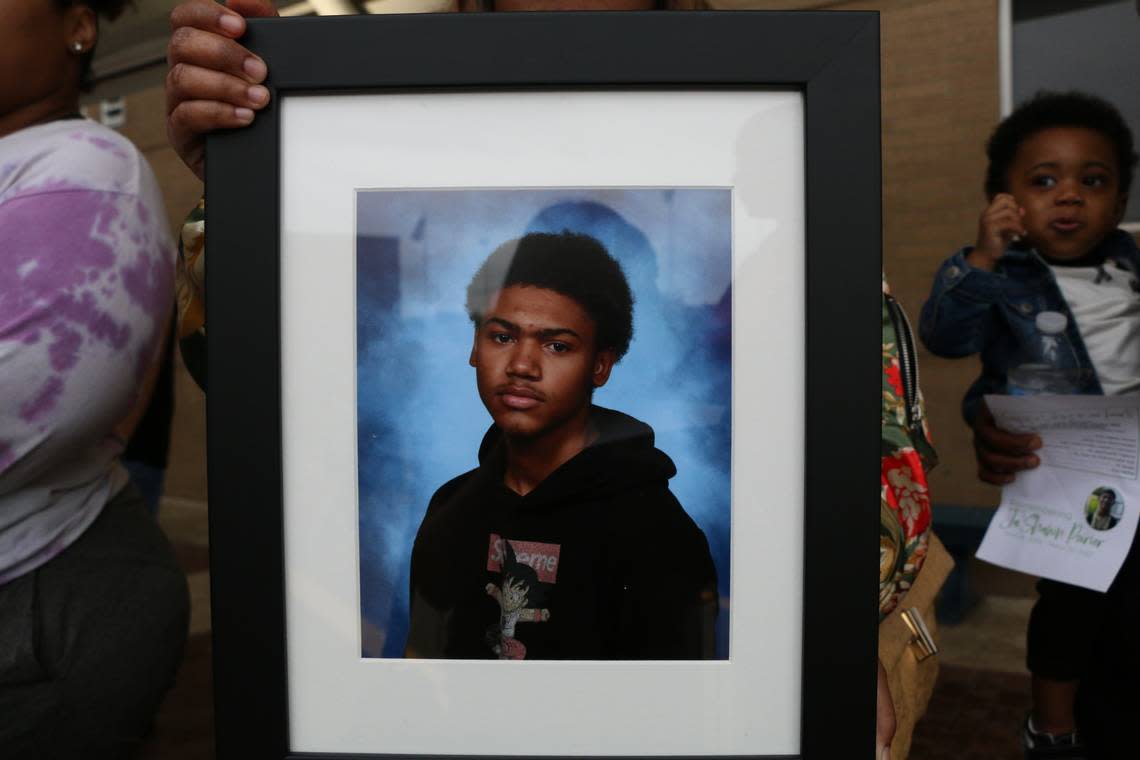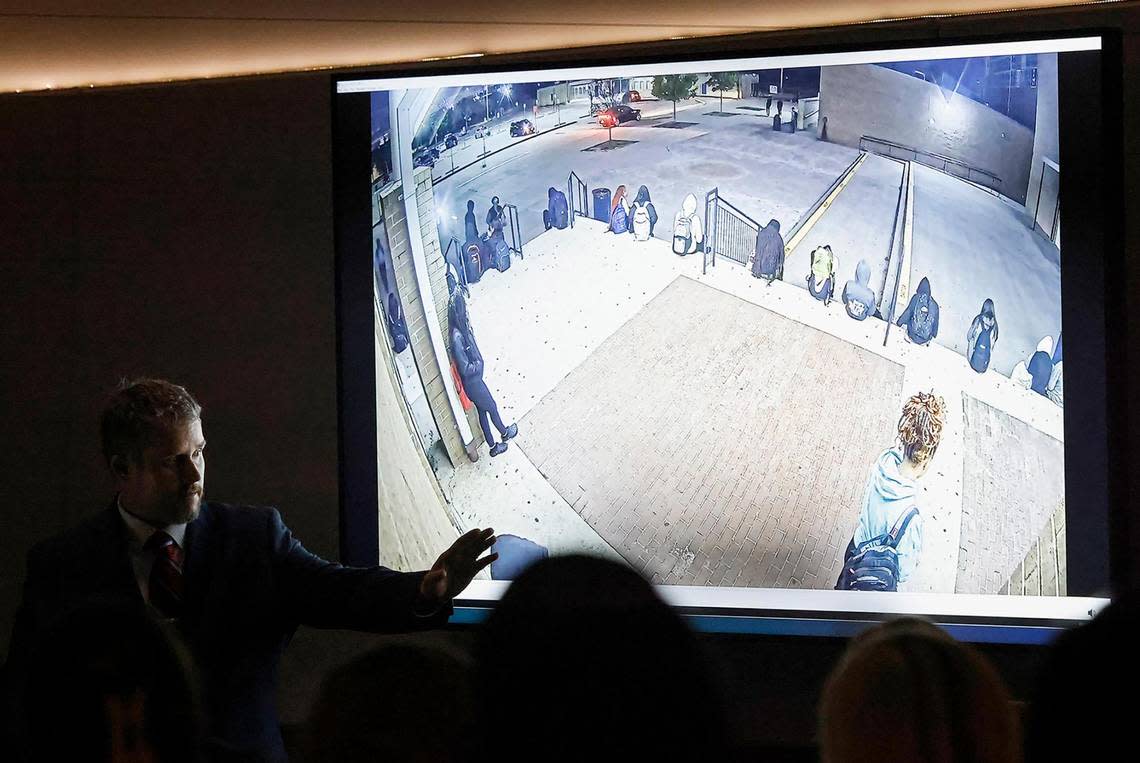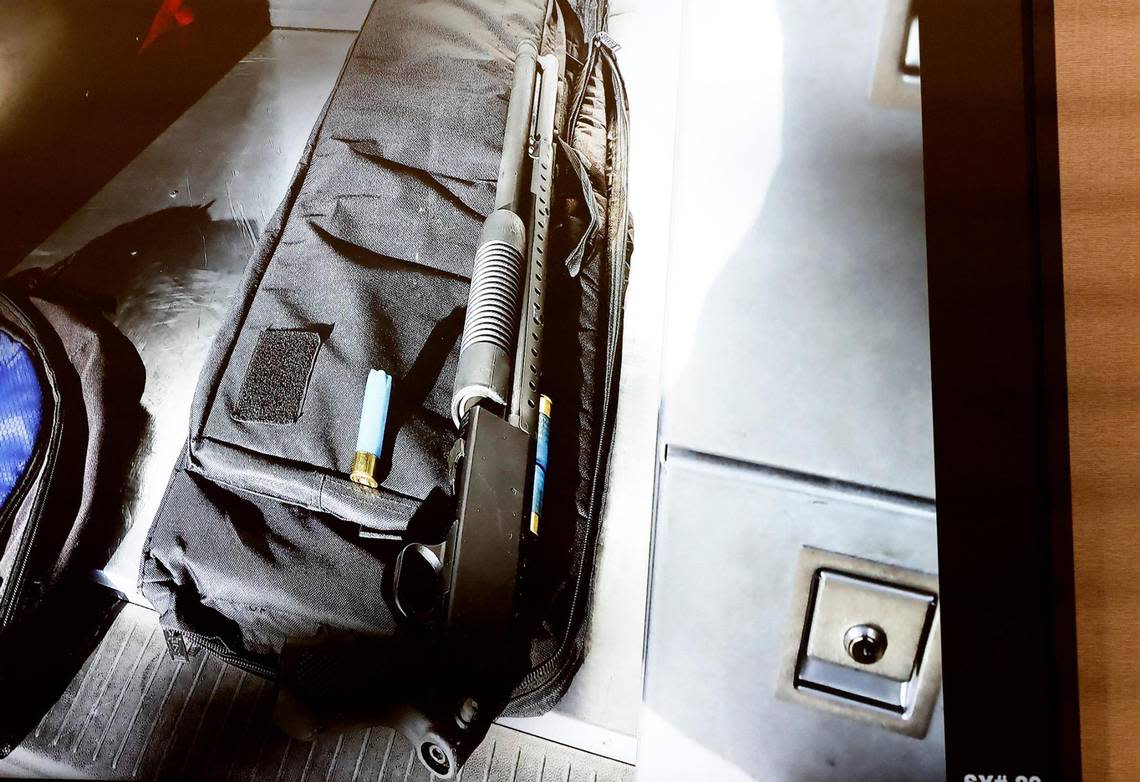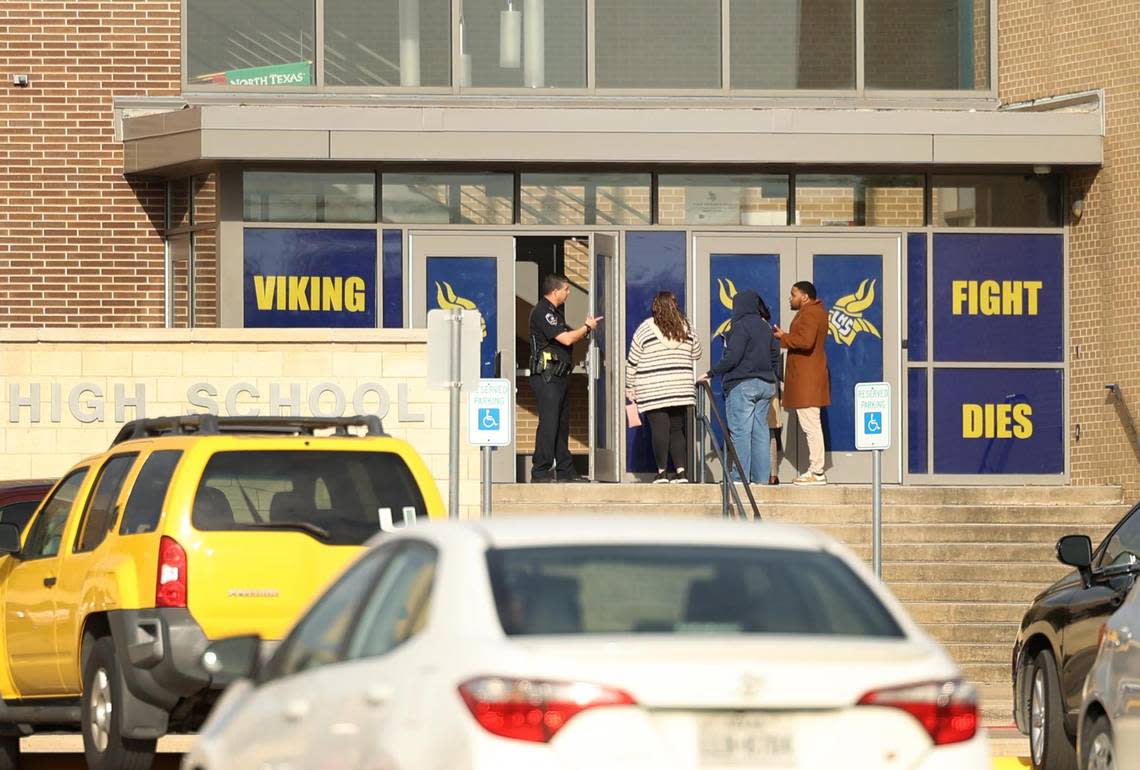Lamar High School shooting jurors watch video of killing, hear from surviving victim
The teenager who shot and killed another student at Lamar High School in Arlington on March 20 raised himself, his defense attorneys told jurors in opening statements at his disposition, or sentencing, trial Tuesday in Tarrant County Juvenile Court.
After Tarrant County Assistant Criminal District Attorney Lee Sorrells told jurors that prosecutors are asking for the 40-year maximum sentence for a juvenile who has been found guilty of capital murder, defense attorney Frank Adler said the defense would not be asking for the minimum sentence of no punishment.
“He deserves to be punished,” Adler told the jurors. “And it’s a big ask that we’re asking the 12 of you to punish him.”
Both Sorrells and Adler agreed that video and photo evidence that will be presented to jurors throughout the trial would be hard to watch.
“There’s nothing more terrible or terrifying for a kid than sitting there at a school, and then getting shot,” Sorrells said. “Getting killed.”
Ja’Shawn Poirier, 16, was fatally shot and another student was wounded. The shooter, who was 15 at the time of the killing, pleaded “true,” or guilty, last week to one count of capital murder and three counts of attempted capital murder.

After opening statements Tuesday for the sentencing, Sorrells called the teenage girl who survived the shooting but was wounded and scarred to the witness stand. He then showed the jury a video of the morning of the shooting. In the video, students sitting on the steps outside the school before classes started the morning of March 20 are seen fleeing after shots are fired.
In another angle of the video, jurors could see clearly Poirier collapse and then remain on the ground after the shots were fired.
The injured girl testified that she hid behind a pillar with a large group of other students, seeking safety, but shrapnel from the gunman’s shotgun hit her in the face.

The teen who committed the shooting came into court Tuesday wearing his corrections uniform, leading to advice from Juvenile Court Judge Alex Kim’s that he should consider wearing “civilian clothes.” The judge made sure the teen knew about his right to wear civilian clothing and asked a series of questions about why he was wearing the beige uniform issued by the jail, to which he responded that it was voluntary.
The judge also told the teen he had a right to change into civilian clothes during any normal break before further warning him that the clothes he decides to wear could impact the way the jury views him, saying it could create sympathy or cast him in a negative light.
An Arlington police officer was called to the stand to tell jurors about how he was responding to the scene when he saw the teen who committed the shooting. When the shooter, walking near the intersection of Lamar Boulevard and Cooper Street, saw the officer turning around to stop him, he began running, the officer testified.
As he ran, the officer said, the teen dropped the backpack he was carrying which contained the shotgun used in the killing.

After the mid-morning break, jurors were shown body-camera footage from the first Arlington police officer to arrive at the scene. The footage shows Officer Lyman jumping out of his vehicle when he and a recruit arrived at the school.
In the video, Lyman runs toward the steps to the school, taking over CPR from a security guard who was already attempting life-saving measures on Poirier. The security guard told Lyman he didn’t know where the gunshot wound was, but that he heard two shots.
Officers continued chest compressions until paramedics arrived. Poirier, whose brain stem was severed by buckshot, was not breathing on his own. One paramedic noted that it appeared Poirier been shot through his neck.
Family of Poirier in the courtroom were in tears as they and the jury watched the video of police attempting lifesaving measures. Some relatives had to exit the courtroom after a few minutes.
As the video showed first responders continuing CPR, word came in over the police radio that officers had recovered the weapon used in the shooting and that officers needed assistance in setting up a perimeter. Lyman later coached his trainee officer on how to talk to the girl who was grazed in the face before getting a statement from her about what she saw, the video showed.
Attorneys on both sides of the case sparred again over the validity of a sexual assault report made by the shooter after he was arrested. He said that when he opened fire he thought he saw two of the people who had attacked him in a school bathroom.
About 20 students were outside on the steps when he opened fire.
The teen told a forensic interviewer that he was assaulted in early October after returning to school following a trip when he visited his mother in Louisiana.
Arlington police Crimes Against Children Detective Vanessa Barnes told jurors that she investigated the claims and found that evidence did not line up with what he said. She cited a trash can he described as holding open a bathroom door that was missing, a teacher not recalling his long absence from her class after leaving for a bathroom break and the information that one of the boys he claimed committed the assault would not have been on campus around that time.
Herrick, the defense attorney, pointed out that the accused sexual assault happened six months before March 20, when the shooting happened and the teen told police about the assault. Barnes also told jurors that, at one point, she informed prosecutors that she believed that a sexual assault did occur but that she wasn’t confident in the identities of the suspects picked out of yearbook photos by the teen.
She told the jury in response to Herrick’s questioning that the details he provided — including facial expressions, sounds, feelings, sights, blood on the floor after the assault, his attackers laughing at and mocking him, other sensory details and that he sat in the bathroom crying afterward — were consistent with a child truthfully describing a sexual assault.
But she also told jurors in court Tuesday that she no longer believes that his story was truthful.
It’s the same conclusion Barnes shared with the court in June, in a pretrial hearing. At that time, she also said that at least one of the students was required to be outside the school when the sexual assault the teen described would have occurred.
Also in that pretrial hearing, Caleb Blank, a district attorney’s office investigator, testified that in a phone interview the teen’s mother questioned the validity of her son’s sexual assault report. The district attorney’s office investigator said the mother said that she had not seen any changes in his behavior or demeanor before or after when he said the assault occurred.
In opening statements Tuesday morning, defense co-council Adler told the jury the teen’s mother hasn’t visited him once since his arrest. In June, Blank told the court that the mother said she had not been to see him because she thought he would decline to see her and he hadn’t called her since his arrest.
The sexual assault the teen reported would have happened before a fight at the school that ended with a three-day suspension for him, Lamar High School Vice Principal Teri Williams testified. She told jurors that following the fight, the teen had been involved in two more incidents where he was physically aggressive, including one where he slapped the phone out of the hand of another student, but that those incidents did not turn into fights.
She also noted that he had more than 100 unexcused absences by the day of the shooting on March 20, and that most of those unexcused absences happened after the fight. Prior to that, Williams testified that the teen had some excused absences and was tardy to some classes.
She also told the jury that she had been in contact with the teen’s father, but that any time she wanted to meet with him she would have to schedule the meeting a week in advance.
The first time she talked with the teen’s father, who is now in federal prison after pleading guilty to charges of illegally possessing firearms as a felon, was after the fight, she said. She had never spoken to his mother and did not have her number listed as an emergency contact.
Details about how the 15-year-old tried to escape from the juvenile corrections facility were hinted at a few times during the trial, but specifics were not allowed to be presented in court Tuesday because some of the facts have not been formally introduced into evidence.
This came up when lawyers questioned a psychologist who conducted an evaluation of the teen in June. She found, among other things, that he was a moderate risk for future violence, had below average sophistication, above average maturity and had a complicated relationship with his father. It was noted, though, that he displayed signs of being defensive in his personality evaluation and that the results should be approached with some measure of caution.
When it came to family relationships, the teen initially indicated in the evaluation interview that he had an OK relationship with his father, then later said he was forced to move to Texas from Louisiana by his mother and that the relationship became more complicated in October 2022 when his father began drinking and smoking cigarettes.
When asked about the escape attempt, the expert told jurors she would not have been surprised to learn that he had attempted an escape because of immense emotional pressure the day before he was originally supposed to go to trial.
The trial is expected to run through Thursday.
On Monday, attorneys for the state and defense questioned potential jurors about their backgrounds, their biases, and whether they could ever imagine themselves handing up the maximum sentence of 40 years or the minimum sentence of no disposition, meaning no time on probation or behind bars.
During jury selection before the panel was reduced to the final 12 jurors and two alternates, at least nine of the potential jurors told Kim they didn’t think they could be fair and impartial, or only consider evidence presented in court during jury deliberations, because of news coverage they’d read or heard or news they knew about secondhand before the trial.
The case has been high profile since the shooting happened in March, along with other shootings and threats at schools in Tarrant County and other parts of Texas in recent years.

Earlier this year, Timothy Simpkins, 19, was sentenced to 12 years in prison and a $6,000 fine for attempted capital murder at Timberview High School in Mansfield. That shooting happened in October 2021.
